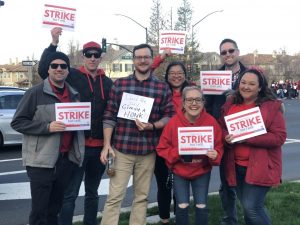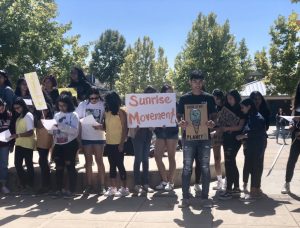Strikes during the COVID-19 pandemic signal the comeback of the Labor Movement
It is crucial to stand in the face of injustice.
June 9, 2022
Following a strike by nurses at Stanford Health Care and Lucile Packard Children’s Hospital, the hospital worker’s union, the Committee for Recognition of Nursing Achievement (CRONA), negotiated higher wages and improved health benefits for employees on May 2.
The strike was precipitated on April 25, due to hospital workers’ concerns over understaffing and mental health.
“We’ve been disappointed by hospital administrators’ consistent refusal to acknowledge the reality of understaffing: constant requests for overtime, little time for rest with our families and insufficient support for our mental health,” CRONA President Colleen Borges explained.
Following roughly a week of striking, CRONA was able to negotiate new contracts, including provisions for safer staffing, improved wages, medical and mental health benefits and more vacation rights.
“CRONA’s new contracts represent an enormous victory for nurses at Stanford and Packard, who have been fighting tirelessly for improved work and patient care conditions,” Borges stated.
The recent strike is just another example testifying to the effectiveness of strikes and organized labor in promoting workers’ rights.
Strikes and unions have been a part of American culture from the very beginning. Starting in 1619, the first documented strike took place in Jamestown, Virginia, where skilled craftsmen who weren’t of English descent were not permitted to vote. In return, they refused to work unless given the right, and under this pressure, the Virginia Company council finally acquiesced.
As the Global Nonviolent Action Database states, “Presumably fearful of the economic impact of this strike, the English decided to extend the franchise to the Polish workers and make them ‘as free as any inhabitant there whatsoever,’ likely referring to the extension of all political and civil rights afforded to the English. In exchange, the Polish artisans agreed to teach their craft to others in the colony.”
This would mark the beginning of a long history of unions and strikes, with their effectiveness waxing and waning with the times. The archetype of the union worker has had mixed historical interpretations, from chaotic rabble-rousers to exemplars of grit and perseverance. This is somewhat due to the effectiveness of the strikes. For example, the strikers of the Ludlow massacre, where anti-striker forces killed 21 strikers and injured dozens more, were seen in a more sympathetic light than say, that of Haymarket Square, where suspected anarchists were put on trial after a bomb at the event killed several police officers. These events often determined public views and support of unions during that era.
In pre-pandemic years, labor unions were on the waning side of effectiveness. In 1947, the passage of the Taft-Hartley Act, which modified the previous union-empowering Wagner Act, essentially kneecapped union power by restricting what a union could and couldn’t do, including raising external campaign funds for political endorsement and requiring unions to give an 80-day notice to employers and the authorities before a strike, giving them ample amount of time to prepare a response.
This was further compounded by various social and economic changes such as the shift from an industrial economy to a service industry based economy in the 1970s. This shift caused the primarily industrial focused union movement to slide into decline.
Effectiveness of strikes and labor unions today
Yet, like the Stanford strike, many strikes and labor movements during the COVID-19 pandemic today have effectively worked towards improved wages and better working conditions. This is mainly due to the growing support toward union efforts. According to Gallup, union support during the past few years has been steadily increasing since a low in 2009.
While some strikes may be classified as unlawful because of conditions such as the purpose of the strike or the conduct of strikers, the National Labor Relations Board explains that workers can strike for a variety of “lawful objects,” including striking for economic reasons (e.g. increased wages, improved working conditions and shorter working hours) and striking against unfair labor practices. Thus, when workers lawfully refuse to work as part of a strike, they are exercising their right to strike and voice their desire for a better workplace.
For instance, following a strike at John Deere in Nov. 2021, members of the United Autoworkers Union (UAW) were able to negotiate an immediate $8,500 ratification bonus and 10% wage increase, as well as additional increases throughout the lifetime of the contract.
“They have started a movement for workers in this country by what was achieved here today and they have earned the admiration and respect of all that strive for what is just and equitable in the workplace,” UAW Vice President Chuck Browning said in a statement.
Another strike at Kellogg’s factories in late 2021 also illustrated workers exercising their rights to strike; the strike lasted for 11 weeks and led to increased wages and benefits for employees.
“From picket line to picket line, Kellogg’s union members stood strong and undeterred in this fight, inspiring generations of workers across the globe, who were energized by their tremendous show of bravery as they stood up to fight and never once backed down,” the Bakery, Confectionery, Tobacco Workers and Grain Millers’ International Union said in a statement on the strike.
Through the volatility of the COVID-19 pandemic, the labor movement has become increasingly important for workers to stand up for improved working environments.
“Because we stood strong together for fair contracts that support nurses and our patients, the hospitals could not ignore our demands. We won improvements across every single priority area we set out to,” CRONA said of the recent Stanford nurse strike.







